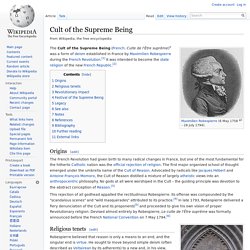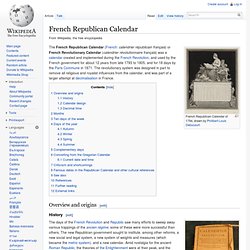

Untitled. The Project Gutenberg EBook of Emile, by Jean-Jacques Rousseau This eBook is for the use of anyone anywhere at no cost and with almost no restrictions whatsoever.

You may copy it, give it away or re-use it under the terms of the Project Gutenberg License included with this eBook or online at www.gutenberg.org Title: Emile Author: Jean-Jacques Rousseau Posting Date: September 26, 2011 [EBook #5427] Release Date: April, 2004 [This file was first posted on July 18, 2002] Language: English Produced by Steve Harris, Charles Franks and the Online Distributed Proofreading Team. By Jean-Jacques Rousseau Translated by Barbara Foxley Author's Preface This collection of scattered thoughts and observations has little order or continuity; it was begun to give pleasure to a good mother who thinks for herself. We know nothing of childhood; and with our mistaken notions the further we advance the further we go astray. There are two things to be considered with regard to any scheme. What is this goal? Public-safety.jpg (JPEG Image, 360x470 pixels) Fête de l'Etre suprême 2.jpg - Wikipedia, the free encyclopedia.
The Enlightenment (1650–1800): Key People & Terms. People Johann Sebastian Bach (1685–1750) An enormously influential German composer who rose to prominence in the early 1700s.

Best known by his contemporaries as an organist, Bach also wrote an enormous body of both sacred and secular music that synthesized a variety of styles and in turn influenced countless later composers. Francis Bacon (1561–1626) An English philosopher and statesman who developed the inductive method or Baconian method of scientific investigation, which stresses observation and reasoning as a means for coming to general conclusions. Cesare Beccaria (1738–1794) An Italian politician who ventured into philosophy to protest the horrible injustices that he observed in various European judicial systems. John Comenius (1592–1670) Reign of Terror (1949. Great Speeches Collection: Maximilien Robespierre Speech on the Festival of the Supreme Being. Cult of the Supreme Being. The Cult of the Supreme Being (French: Culte de l'Être suprême)a was a form of deism established in France by Maximilien Robespierre during the French Revolution.[1] It was intended to become the state religion of the new French Republic.[2] Origins[edit] The French Revolution had given birth to many radical changes in France, but one of the most fundamental for the hitherto Catholic nation was the official rejection of religion.

The first major organized school of thought emerged under the umbrella name of the Cult of Reason. Advocated by radicals like Jacques Hébert and Antoine-François Momoro, the Cult of Reason distilled a mixture of largely atheistic views into an anthropocentric philosophy. Republic of Virtue. The "Republic of Virtue" was a period in French history (1791-1794) marked by the ascendancy of Maximilien Robespierre.

Many proponents of the Republic of Virtue developed their notion of civic virtue from the writings of Jean-Jacques Rousseau (1712-1778). The idea of the "Republic of Virtue" has associations with the de-Christianization of France during the French Revolution. The de-Christianization process involved the closing of churches, Protestant and Catholic, as well as selling many church buildings to the highest bidders. Many churches became store-houses for arms or grain. Civic virtue. Republican virtue[edit] Civic virtues have historically been taught as a matter of chief concern in nations under republican forms of government, and societies with cities.

When final decisions on public matters are made by a monarch, it is the monarch's virtues which influence those decisions. When a broader class of people become the decision-makers, it is then their virtues which characterize the types of decisions made. This form of decision-making is considered superior in determining what best protects the interests of the majority. Aristocratic oligarchies may also develop traditions of public lists of virtues they believe appropriate in the governing class, but these virtues differ significantly from those generally identified under the category of civic virtue, stressing martial courage over commercial honesty.
In ancient Greece and Rome[edit] French Republican Calendar. The French Republican Calendar (French: calendrier républicain français) or French Revolutionary Calendar (calendrier révolutionnaire français) was a calendar created and implemented during the French Revolution, and used by the French government for about 12 years from late 1793 to 1805, and for 18 days by the Paris Commune in 1871.

The revolutionary system was designed in part to remove all religious and royalist influences from the calendar, and was part of a larger attempt at decimalisation in France. Overview and origins[edit] History[edit] Committee of Public Safety. Comité de Salut Public, 1794.

Anonymous French print, 18th century. The Committee of Public Safety (French: Comité de salut public), created in March 1793 by the National Convention and then restructured in July 1793, formed the de facto executive government in France during the Reign of Terror (1793–1794), a stage of the French Revolution. The Committee of Public Safety succeeded the previous Committee of General Defence (established in January 1793) and assumed its role of protecting the newly established republic against foreign attacks and internal rebellion.
As a wartime measure, the Committee—composed at first of nine, and later of twelve members—was given broad supervisory powers over military, judicial, and legislative efforts. Declaration of the Rights of Man - 1789. The Enlightenment (1650–1800): The French Enlightenment. Events 1715 Louis XIV dies; Louis XV takes French throne 1748 Montesquieu publishes The Spirit of Laws 1751 Diderot publishes first volume of Encyclopédie 1759 Voltaire publishes Candide Key People Louis XIV - “Sun King” whose late-1600s extravagance prompted disgruntled French elites to congregate in salons and exchange ideas Louis XV - Successor to Louis XIV; ineffective ruler who allowed France to slide into bankruptcy; ineptness greatly undermined authority of French monarchy.

Jacques Necker. Necker, 1789 engraving Jacques Necker (30 September 1732 – 9 April 1804) was a French statesman of Swiss birth and finance minister of Louis XVI, a post he held in the lead-up to the French Revolution in 1789.

Early life[edit] Necker was born on 30 September 1732 in Geneva, then an independent republic. His father Karl Friedrich Necker was a native of Küstrin in Neumark (Prussia, now Kostrzyn nad Odrą, Poland), and had, after the publication of some works on international law, been elected as professor of public law at Geneva, of which he became a citizen. Jean-Paul Marat. Jean-Paul Marat (French: [ʒɑ̃pɔl maʁa]; 24 May 1743 – 13 July 1793), born in the Principality of Neuchâtel, was a physician, political theorist and scientist best known for his career in France as a radical journalist and politician during the French Revolution.

Age of Enlightenment. The Age of Enlightenment (or simply the Enlightenment, or Age of Reason) is an era from the 1650s to the 1780s in which cultural and intellectual forces in Western Europe emphasized reason, analysis and individualism rather than traditional lines of authority. It was promoted by philosophes and local thinkers in urban coffeehouses, salons and masonic lodges. It challenged the authority of institutions that were deeply rooted in society, such as the Catholic Church; there was much talk of ways to reform society with toleration, science and skepticism. New ideas and beliefs spread around the continent and were fostered by an increase in literacy due to a departure from solely religious texts. Publications include Encyclopédie (1751–72) that was edited by Denis Diderot and (until 1759) Jean le Rond d'Alembert.
Some 25,000 copies of the 35 volume encyclopedia were sold, half of them outside France. Flag of France. Design[edit] The colours adopted by Valéry Giscard d'Estaing, which replaced a darker version of the flag. Currently, the flag is 50 percent wider than its height (i.e. in the proportion 2:3) and, except in the French navy, has stripes of equal width. Initially, the three stripes of the flag were not equally wide, being in the proportions 30 (blue), 33 (white) and 37 (red). Under Napoleon I, the proportions were changed to make the stripes' width equal, but by a regulation dated 17 May 1853, the navy went back to using the 30:33:37 proportions, which it continues to use, as the flapping of the flag makes portions farther from the halyard seem smaller. Symbolism[edit] Multiple French flags as commonly flown from public buildings. Maximilien Robespierre.
Maximilien François Marie Isidore de Robespierre (IPA: [mak.si.mi.ljɛ̃ fʁɑ̃.swa ma.ʁi i.zi.dɔʁ də ʁɔ.bɛs.pjɛʁ]; 6 May 1758 – 28 July 1794) was a French lawyer and politician, and one of the best-known and most influential figures of the French Revolution. Jacobin. Jacobin is separate and distinct from Jacobite and Jacobian. The door of the Jacobin Club was in the Rue Saint-Honoré, Paris. The Society of the Friends of the Constitution (French: Société des amis de la Constitution), commonly known as the Jacobin Club (Club des Jacobins, pronounced: [ʒa.kɔ.bɛ̃]) was the most famous and influential political club in the development of the French Revolution,[1] so named because of the Dominican convent where they met, which had recently been located in the Rue St.
Jacques (Latin: Jacobus), Paris. The club originated as the Club Benthorn, formed at Versailles from a group of Breton representatives attending the Estates General of 1789.[1] There were thousands of chapters throughout France, with a membership estimated at 420,000. Joseph-Ignace Guillotin. Dr. Joseph-Ignace Guillotin (French pronunciation: [ɡijɔtɛ̃]; 28 May 1738 – 26 March 1814) was a French physician who proposed on 10 October 1789 the use of a device to carry out death penalties in France. While he did not invent the guillotine, and in fact opposed the death penalty, his name became an eponym for it.
Georges Danton. Early life and the revolution[edit] Danton was born in Arcis-sur-Aube in northeastern France to Jacques Danton and Mary Camus, Brittany from a respectable, but not a wealthy family. After obtaining a good education he became an Advocate in Paris.[3] He married Antoinette Charpentier in 1787; they had three sons. She died 10 February 1793, whereupon Danton married Louise Sébastienne Gély, aged 16, daughter of Marc-Antoine Gély, huissier-audiencier at the Parlement de Paris and member of the Club des Cordeliers. She looked after his two surviving sons. Charlotte Corday. Marie-Anne Charlotte de Corday d'Armont (27 July 1768 – 17 July 1793), known to history as Charlotte Corday (French: [kɔʁdɛ]), was a figure of the French Revolution.
In 1793, she was executed under the guillotine for the assassination of Jacobin leader Jean-Paul Marat, who was in part responsible, through his role as a politician and journalist, for the more radical course the Revolution had taken. More specifically, he played a substantial role in the political purge of the Girondins, with whom Corday sympathized. His murder was memorialized in a celebrated painting by Jacques-Louis David which shows Marat after Corday had stabbed him to death in his bathtub. Mail - Unread(1409)